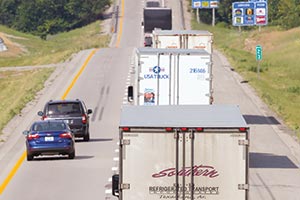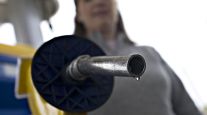EPA Reaffirms Right to Regulate Trailers, Glider Kits in GHG Rule

This story appears in the March 21 print edition of Transport Topics.
Responding to criticism from trailer manufacturers and glider kit makers, the Environmental Protection Agency published a draft memorandum reaffirming the agency’s authority to regulate the two groups on carbon dioxide output and other greenhouse-gas emissions.
Even though trailers and gliders are not complete vehicles by themselves, the agency said they are highly significant components of tractor-trailer combinations and therefore they can be regulated under the terms of the Clean Air Act.
Protests by the two groups of manufacturers came in response to the proposed Phase 2 greenhouse-gas rule in June from EPA and the National Highway Traffic Safety Administration to regulate greenhouse gases from heavy- and medium-duty trucks.
“EPA may reasonably classify trailer manufacturers and glider kit manufacturers as motor vehicle manufacturers, although we also believe that EPA would have adequate authority for the standards, even if these entities were classified simply as manufacturers of motor vehicle parts,” according to the memo posted in the Federal Register on March 2 as part of a Notice of Data Availability on Phase 2.
Top executives with the Truck Trailer Manufacturers Association said they would prefer to work out differences with EPA before publication of the final rule, currently expected in August, but that litigation could be the result instead.
“Obviously, we see some flaws in their reasoning, but we’re working toward a response,” said association President Jeff Sims. “They don’t understand the nature of our business.”
“We’re not controlling all of these details that our customers specify,” Sims said.
TTMA engineering manager John Freiler said that “across-the-board prescriptions are the problem” with the proposal.
The association endorses EPA’s voluntary SmartWay program, which recommends technologies such as low-rolling-resistance tires and aerodynamic fairings.
While many fleets have adopted these suggestions, they don’t work well in all cases.
“Pickup-and-delivery fleets that don’t travel at a high rate of speed get zero benefit from the aero devices,” Sims said.
Aerodynamic devices smooth out airflow so that the truck’s engine doesn’t have to work hard and generate as much carbon dioxide.
Freiler said trailers that travel through rough, off-road environments usually need tires that are tougher than low-rolling-resistance models. He also criticized a regulatory call for making automated tire-inflation systems mandatory, saying that in some user applications, simpler tire-pressure monitoring systems work better.
“We want regulators to be informed,” Sims said, adding that his “members are definitely concerned” and that litigation is “still on the table” if an understanding cannot be reached.
Trailers were not part of the Phase 1 GHG rule that took effect on trucks made in January 2014. The Phase 2 proposal includes trailers in 2018 and further tightens rules on tractors in the 2021 model year.
As for gliders, the EPA memo offered some flexibility, depending upon the date the engine was originally manufactured.
Gliders combine new and old machinery into a new truck. A refurbished part of an older powertrain — engine, transmission or drive axles — is joined with a glider kit, or the balance of a new tractor.
The EPA lawyers who drafted the memo said an alternative to accept engines from 2010 to the present is possible, as they minimize the release of nitrogen-oxide compounds and particulate matter, often called criteria pollutants.
Daimler Trucks North America makes glider kits for its Freightliner and Western Star models. Its website says: “Gliders are a faster, more cost-effective solution for standardizing multiple fleet units, or for repairing units down due to wreck or fire.”
DTNA spokesman David Giroux said the company is drafting comments for EPA about gliders.
Kenworth Trucks and Peterbilt Motors, both units of Paccar Inc., also make glider kits, but Kenworth spokesman Jeff Parietti declined to comment on the issue.
Other original equipment manufacturers oppose gliders.
“Navistar generally supports the EPA’s proposed rule on glider kits, suggesting that the glider allowance should be reduced or eliminated,” said Navistar International Corp. spokeswoman Lyndi McMillan. “We believe that allowing the use of glider kits is counterproductive to the increasingly strong federal and state environmental regulations on ozone, greenhouse gas and particulate matter.”
Volvo Group did not offer comment for this story, but the company’s former CEO, Olof Persson, said in a speech a year ago that gliders “allow older, dirtier engines to remain in new trucks. I find it curious they are so broadly permitted,” adding that Volvo Trucks and Mack Trucks would not make them.
Engines made from October 2002 through 2009 also were given some credit for reduced criteria pollutants, but EPA really wants to purge engines made before then, although they are often the most sought-after engines among glider purchasers.




